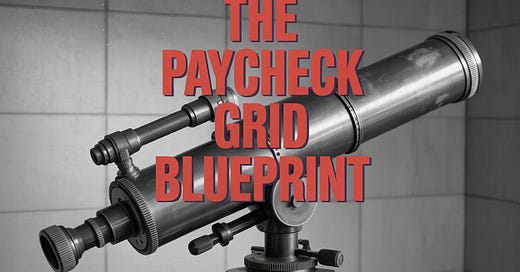The “4% Rule” concept is simple: save up a pile of money, sell off 4% each year, and hope for the best. I agree, for a time it seemed like a reasonable guideline.
But in the world of higher inflation and unpredictable markets, relying on this old rule creates a constant feeling of anxiety, and frankly I believe we need a more durable approach.
So, I went back to first principles to engineer a system designed for resilience and control.
I call it the Paycheck Grid — a system for converting your portfolio into a reliable, monthly paycheck.
Instead of just drawing down your savings, you'll be putting them to work.
Today, I’m giving you the blueprint.
The Flaw in Conventional Retirement Thinking
Traditional planning asks you to think of your retirement savings as one big pile of money.
The first problem with this view is that it's psychologically draining.
Every dollar you spend makes the pile shrink and it feels like a countdown clock.
My Paycheck Grid flips that idea on its head. You stop focusing on your pile shrinking and start focusing on your paycheck growing.
I designed it like a custom-built engine.
Let's build your machine, piece by piece.
We build the grid from two types of components: the foundational blocks that provide stability, and the powerhouse blocks that generate torque.
Part 1: The Foundation (The Passive Engine)
These components are designed for stability and automated cash flow, forming the steady, reliable hum of the engine.
Block 1: The Bedrock – SGOV, Your Portfolio’s Central Bank
Current Yield: ~4.2%
Monthly Paycheck: Roughly $35 per $10,000 invested.
First up is the iShares 0-3 Month Treasury Bond ETF (SGOV).
The purpose of this block is not to make you rich.
Its purpose is capital preservation, liquidity, and operational readiness.
Think of this block as your portfolio's internal bank account.
It's where the income premiums you generate are deposited, and the account you can tap for living expenses without having to sell equities in a downturn.
Backed by the full faith and credit of the U.S. government, it is the closest thing to zero-risk capital that still pays you a yield. For a retiree, the psychological anchor of this stable cash block is invaluable.
Block 2: The Workhorse – JEPI and Automated Equity Income
Current Yield: ~8.3%
Monthly Paycheck: Roughly $69 per $10,000 invested.
Next is the JPMorgan Equity Premium Income ETF (JEPI).
This is your hybrid engine, offering both equity exposure and a powerful income stream. Under the hood, the fund managers hold a portfolio of S&P 500 stocks while also systematically selling call options against the index.
It is essentially a managed, one-click version of the covered call strategy we champion.
You definitely can replicate it yourself, but if you’d rather play golf or spend time with your family, the management fee on JEPI is a price worth paying for instant diversification and automated execution.
Here, we must understand the engineering trade-off.
JEPI's high yield comes at a price: in a screaming bull market, it will almost certainly lag the pure S&P 500. The options strategy that generates its high income also caps some of the potential upside.
You are explicitly choosing a higher, more immediate monthly paycheck in exchange for capturing less of a potential, but uncertain, market rally.
But if you prioritize cash flow today over chasing market highs tomorrow, this is a very good trade-off.
Part 2: The Powerhouse (The Active Boosters)
This is where we transition from being a passive investor to an active engineer.
We add "booster blocks" to the grid to significantly increase our monthly cash flow.
We do this by deploying our core options strategy—the "Wheel"—on blue-chip stocks.
The stocks we use for this are not random picks. They are VADER-approved.
These traits are essential for an options strategy.
We need the dividend for a yield buffer, the strong financials to ensure we're comfortable owning the stock through a downturn, and the resilience that leads to more predictable option pricing.
Crucially, their options are highly liquid, allowing us to trade with minimal friction.
The Wheel strategy is a pretty simple, two-part cycle:
We get paid to wait to buy stocks we love at a discount (by selling cash-secured puts).
If we end up buying them, we then get paid again to agree to sell them later at a profit (by selling covered calls).
A Live-Fire Example: The Coca-Cola Wheel
A quick note before we begin: The numbers in this example are real, based on market data from last week when this was written. This is not a trade recommendation—this is a process illustration. Your goal is not to replicate these exact numbers, but to understand the evergreen mechanics. The numbers change daily; the engineering process does not.
OK, Let’s assume KO is trading at $70/share.
Month 1: Selling the Put
We want to buy KO, but we'd prefer to get it at a discount.
So, we sell a one-month cash-secured put with a $68 strike price.
The market pays us $60 in premium for this contract.
We are targeting a delta around 0.25, which gives us a high probability of success.
We are not gambling on a 50/50 coin flip; essentially are acting as the house that is selling insurance to the speculators.
→ Outcome: KO closes the month at $70.50. The put expires worthless. We simply keep the $60 cash. We made a 0.88% return on our collateral in one month.
Month 2: Trying Again
We repeat the process, selling another one-month $68 put and collecting another, say, $58 in premium.
→ Outcome: This time, a market dip pushes KO down to $67.50 at expiration. Our put is "assigned," and we are obligated to buy 100 shares of KO for our agreed-upon price of $68. Our total cash outlay is $6,800. However, because we collected two premiums totaling $118, our effective cost basis for these shares isn't $68, but $66.82 ($68 - $1.18). We just bought a world-class company at a discount to where it was trading two months ago.
Month 3: The Other Side of the Wheel
Now we own 100 shares of KO. We immediately put those shares to work.
We sell a one-month covered call with a $70 strike price.
The market pays us another premium, perhaps $55.
→ Outcome: KO rallies to $69.50. The call expires worthless. We keep the $55 premium and our 100 shares. We have now generated $173 in total cash income ($60 + $58 + $55) while acquiring a great asset.
This is the Wheel.
It’s a continuous, logical process of generating income at every stage.
Part 3: The Blueprint (Assembling and Managing the Machine)
You Don't Have to Build It All at Once.
Before you look at the grid, understand this: you do not need to use every block from day one.
The capital required to sell puts on a high-priced stock like Microsoft can be substantial. That is fine.
The beauty of a modular system is that you can start small and scale up.
A beginner can build a powerful income stream using only the SGOV and JEPI blocks.
As you get more comfortable, you can add one options contract on a lower-priced stock like Coca-Cola. You build your machine at your own pace.
Here is the spec sheet.
A "unit" is either $10,000 invested in an ETF or one options contract.
Note: ETF yields are as of mid-2025. Option premiums are estimates for one-month, ~0.25 delta contracts. These numbers fluctuate. The engineering system, however, is evergreen.
Building Your Custom Paycheck: A Practical Example
Let's imagine a retiree with a $500,000 portfolio who wants to generate about $2,500 a month ($30,000 a year).
1. Laying the Foundation:
She allocates $150,000 to JEPI for workhorse income and $100,000 to SGOV for safety and liquidity.
JEPI Paycheck: 15 units x $69 = $1,035/month
SGOV Paycheck: 10 units x $35 = $350/month
Foundation Total: $1,385/month
2. Add the Boosters: She needs another ~$1,100. She has $250,000 of capital remaining (much of it sitting in the SGOV block, acting as collateral).
She sells two JPM puts, generating ~$600/month (using ~$54,000 in collateral).
She sells one MSFT put, generating ~$430/month (using ~$47,500 in collateral).
Booster Total: $1,030/month
Her Total Engineered Paycheck is now $2,415 per month.
She has hit her income target.
Managing the Machine: Risk and Adjustment
Let's analyze the risk.
The total cash required if all three of her puts are assigned at once is roughly $101,500.
This amount is sitting safely inside her $100,000 SGOV block plus cash reserves.
This is not a leveraged bet because it is a fully-collateralized income strategy.
Furthermore, this grid is not static.
If she senses a recession is imminent, she might choose to sell zero MSFT puts for a few months, reducing her risk exposure and relying more on her foundation blocks. If the market is stable, she might add a contract on JNJ to boost income further. The grid is a dashboard you actively monitor and adjust.
The Portfolio at a Glance:
Here is the final structure example of her $500,000 income machine:
Foundation (50%):
$150,000 in JEPI (30%)
$100,000 in SGOV (20%)
Active Options Collateral (~20%):
~$101,500 cash (from the SGOV block and other reserves) set aside to secure put positions.
Reserve Capital (~30%):
~$148,500 remaining liquid and un-allocated, ready for new opportunities or as a safety buffer.
She has a robust income stream, significant reserves, and complete control to adjust the machine's output.
A Critical Note on Taxes
A final, critical point.
The income generated by this grid is not tax-free.
Premiums you receive from options that expire worthless are generally taxed as short-term capital gains in the year you receive them.
The tax implications can be complex, and I will dedicate a future report to tax-optimization strategies for this grid.
For now, speak with a qualified tax professional and be aware that this income is taxable. It's not what you make; it's what you keep.
You Are the Chief Engineer
You now have the foundational blueprint to go from a worried passenger to a confident driver.
But true mastery comes from fine-tuning the engine for maximum monthly cash flow.
That’s precisely what we do inside the Option Income Booster, my dedicated workshop series for Premium Members.
It all starts with my proprietary VADER algorithm, the system I used during my institutional trading years. Each week, it sifts through 3217 stocks to find the absolute best opportunities, which I deliver to you as Put ideas on Thursdays and Call ideas on Sundays.
But a great idea is just the start.
That’s why I show you the entire lifecycle of every position. You'll see how I manage wins, adjust losses, and handle every outcome with total transparency—no surprises.
From my 10 years of mentorship experience, this is the fastest way to build your own trading "muscle memory."
You'll learn to manage trades with professional confidence, spot opportunities that generate consistent high yields, and always have a radar for your next move.
Access to the Option Income Booster is for Premium Members only.
Subscribe below to enter the lab.
Thank you for supporting this project!
Mike Thornton, Ph.D.










Thx for this. 2 questions:
1. Which brokerages permit using SGOV for cash collateral on CCPs? I know Schwab doesn’t.
2. JEPI>SPYI? I believe the latter is newer but the tax advantaged distributions seem compelling.